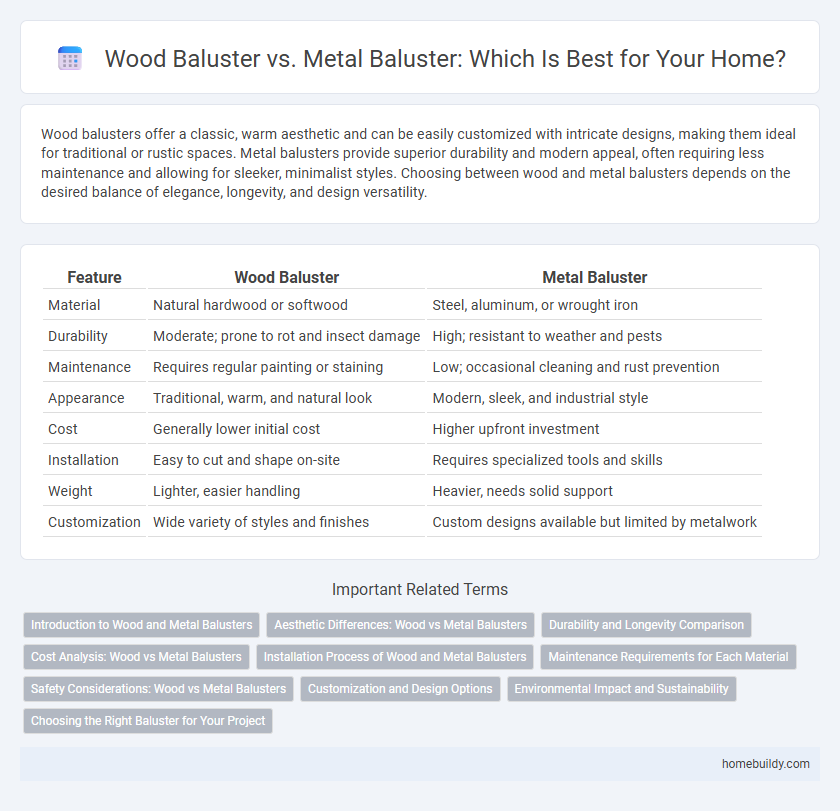Wood balusters offer a classic, warm aesthetic and can be easily customized with intricate designs, making them ideal for traditional or rustic spaces. Metal balusters provide superior durability and modern appeal, often requiring less maintenance and allowing for sleeker, minimalist styles. Choosing between wood and metal balusters depends on the desired balance of elegance, longevity, and design versatility.
Table of Comparison
| Feature | Wood Baluster | Metal Baluster |
|---|---|---|
| Material | Natural hardwood or softwood | Steel, aluminum, or wrought iron |
| Durability | Moderate; prone to rot and insect damage | High; resistant to weather and pests |
| Maintenance | Requires regular painting or staining | Low; occasional cleaning and rust prevention |
| Appearance | Traditional, warm, and natural look | Modern, sleek, and industrial style |
| Cost | Generally lower initial cost | Higher upfront investment |
| Installation | Easy to cut and shape on-site | Requires specialized tools and skills |
| Weight | Lighter, easier handling | Heavier, needs solid support |
| Customization | Wide variety of styles and finishes | Custom designs available but limited by metalwork |
Introduction to Wood and Metal Balusters
Wood balusters offer natural warmth and classic elegance, ideal for traditional staircases and customizable with various wood types such as oak, maple, and cherry. Metal balusters provide sleek durability and modern aesthetics, often crafted from wrought iron, steel, or aluminum for increased strength and low maintenance. Both materials serve distinct design purposes, combining functionality with stylistic expression in interior and exterior applications.
Aesthetic Differences: Wood vs Metal Balusters
Wood balusters offer a warm, traditional aesthetic with natural grain patterns and the ability to be intricately carved or molded for classic designs. Metal balusters provide a sleek, modern look with clean lines and a variety of finishes such as matte black, brushed nickel, or bronze, ideal for contemporary or industrial styles. The choice between wood and metal balusters significantly impacts the overall stairway appearance, blending functionality with the desired architectural style.
Durability and Longevity Comparison
Wood balusters offer a natural aesthetic but are prone to warping, rotting, and insect damage, reducing their durability over time. Metal balusters, especially those made from steel or aluminum, provide superior strength, resistance to weather elements, and require less maintenance, significantly enhancing longevity. Choosing metal balusters ensures a prolonged lifespan and greater structural integrity in outdoor and high-traffic applications.
Cost Analysis: Wood vs Metal Balusters
Wood balusters typically have a lower initial purchase cost compared to metal balusters, making them a budget-friendly option for many homeowners. However, metal balusters often offer greater durability and lower maintenance expenses over time, which can lead to cost savings in long-term use. When considering total ownership cost, including installation and upkeep, metal balusters may provide better value despite higher upfront prices.
Installation Process of Wood and Metal Balusters
Wood balusters require precise cutting and drilling to fit securely into stair rails and treads, often necessitating pre-drilling pilot holes to prevent splitting during installation. Metal balusters typically come pre-measured and pre-cut, allowing for easier mounting using brackets or screws, which accelerates the installation process and provides greater stability. While wood installations demand meticulous sanding and finishing to ensure a smooth and elegant appearance, metal installations often involve less surface preparation, offering a quicker and more durable solution for modern railing systems.
Maintenance Requirements for Each Material
Wood balusters require regular maintenance such as sanding, staining, or painting to protect against moisture, rot, and insect damage, ensuring longevity and aesthetic appeal. Metal balusters, typically made from aluminum, wrought iron, or steel, demand less frequent upkeep, needing only occasional inspection for rust and minor repainting to prevent corrosion. Choosing between wood and metal balusters involves balancing the higher maintenance demands of wood with the durability and low maintenance benefits of metal.
Safety Considerations: Wood vs Metal Balusters
Wood balusters offer a natural, sturdy option but may be prone to splintering or weakening over time, impacting safety if not properly maintained. Metal balusters, often made from steel or aluminum, provide enhanced durability and resistance to impact, reducing the risk of breakage and offering consistent structural support. Fire resistance and resistance to environmental damage are typically superior in metal balusters, making them safer choices in areas prone to moisture or heat exposure.
Customization and Design Options
Wood balusters offer extensive customization options with their ease of carving, staining, and painting, allowing intricate designs and traditional or rustic aesthetics. Metal balusters provide sleek, modern design possibilities with durable finishes and the ability to create minimalist or geometric patterns through welding and bending. Both materials accommodate unique architectural styles, but wood excels in warm, detailed craftsmanship while metal suits contemporary, low-maintenance applications.
Environmental Impact and Sustainability
Wood balusters offer a renewable and biodegradable option, particularly when sourced from sustainably managed forests, reducing carbon footprint and supporting carbon sequestration. In contrast, metal balusters such as aluminum or steel require significant energy for extraction and processing, leading to higher emissions, but they offer enhanced durability and recyclability, extending their lifecycle. Choosing wood balusters can promote sustainability through natural material use, while metal balusters contribute to long-term environmental benefits through recycling and longevity.
Choosing the Right Baluster for Your Project
Wood balusters offer a classic, warm aesthetic and are versatile for various architectural styles, making them ideal for traditional or rustic projects. Metal balusters provide a sleek, modern look with enhanced durability and low maintenance, suitable for contemporary designs or high-traffic areas. Selecting the right baluster involves considering factors such as style preference, maintenance requirements, budget, and environmental exposure.
wood baluster vs metal baluster Infographic

 homebuildy.com
homebuildy.com